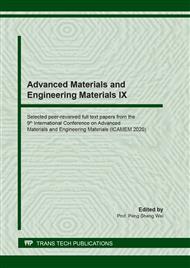[1]
Z. Shaoshi, Z. Zhuo, Composites and viscoelastic mechanics, Mechanical Industry Press, Beijing, (2011).
Google Scholar
[2]
C. Liemin, Y. Baoning, Mechanical analysis of composite materials, China Science and Technology Press, Beijing, (2006).
Google Scholar
[3]
S. Yingcui, Y. Wei, Wang Lipeng, The buckling of AGS cylinders made of CCF300 and T300 under axial compression, Structure & Environment Engineering. 37 (2010): 46-50.
Google Scholar
[4]
C. Gang, W. Dong, T. Zhengneng, et al, Numerical study on property of mechanically fastened joints in stitched laminates, Structure & Environment Engineering. 32 (2005): 6-11.
Google Scholar
[5]
A. Al-Mansour, H. Renwei, C. Xiaoquan, et al, Study on compressive properties of composite laminates with center delamination defect, Structure & Environment Engineering. 34 (2007): 14-21.
Google Scholar
[6]
A.H. Puppo, H.A. Evensen, Interlaminar shear in laminated composite under generalized plane stress, Journal of composite materials. (1970) 204-220.
DOI: 10.1177/002199837000400206
Google Scholar
[7]
S. Tang, A boundary layer theory-part Ⅰ: laminated composites in plate stress, Journal of composite materials. (1975) 33-41.
Google Scholar
[8]
S. Tang, A Levy. A boundary layer theory-part Ⅱ: extension of laminated finite strip, Journal of composite materials. (1975) 42-52.
DOI: 10.1177/002199837500900105
Google Scholar
[9]
S. S. Wang, I. Choi, Boundary-layer effects in composite laminates, part I: free-edge stress singularities, Journal of applied mechanics. 49 (1982) 541-548.
DOI: 10.1115/1.3162514
Google Scholar
[10]
C. Zhang, L. B. Lessard, J. A. Nemes, A closed-form solution for stresses at curved free edges in composite laminates: A variational approach, Composite science and technology. 57 (1997) 1341-1354.
DOI: 10.1016/s0266-3538(97)00061-4
Google Scholar
[11]
H. Mingyong, W. Anwen, Vibration and Interlaminar stress of Orthotropic Laminated Plates , Acta Mechanica Solida Sinica. 29 (2008) 172-174.
Google Scholar
[12]
L. Jipeng; M. Binjie, A survey on the analysis of the interlaminar stress in composite laminates, Structure & Environment Engineering. 40 (2013) 33-41.
Google Scholar


